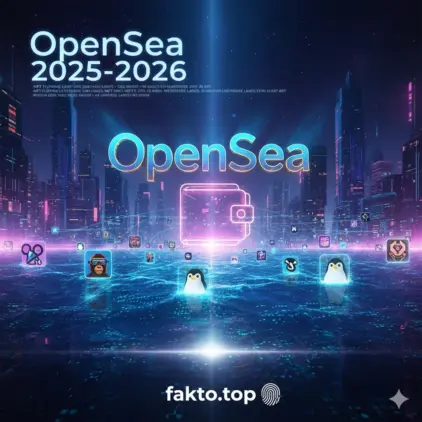OpenSea for Newbies: How to Buy NFTs Without Getting Rugged or Rekt
OpenSea 2025: How to Buy NFT & Flip Digital Assets Like a Pro
Welcome to the world of NFTs — OpenSea can feel like a digital ocean ready to swallow beginners. But here’s the thing: this isn’t just a platform, it’s a launchpad for flipping, collecting, and profiting if you know where to look. Forget fumbling around; this is your OpenSea for Beginners playbook. Ready to ride the crypto wave instead of drowning? Let’s go.
NFTs aren’t just pictures on the blockchain. They are digital ownership, tradable assets, and your ticket into Web3 culture. OpenSea, running on Ethereum and Polygon, is the biggest marketplace for buying NFT gems, checking token history, and minting efficiently. Gas fees exist (we’ll cover that), but with the right strategy, even a newbie can spot underpriced NFTs and flip them for potential gains.

Getting Started: Registering on OpenSea & Connecting Your MetaMask Wallet
Step one: set up your crypto wallet. The most popular choice is MetaMask, your personal vault for NFTs, ETH, and WETH. Guard your seed phrase — it’s your only key to recovery.
How to Create a MetaMask Wallet — Step by Step
- Install the MetaMask browser extension.
- Create a password and safely store your seed phrase.
- Fund your wallet with ETH or USDT — more details here.
Connecting Your Wallet to OpenSea
Go to OpenSea.io, click “Connect Wallet,” and choose MetaMask. Boom — you’re ready to explore the marketplace, browse collections, and start your first NFT flip.
OpenSea Filters — Your Compass in the Tokenverse
OpenSea can feel overwhelming, but its filters are your secret weapon. Search by:
- Category: art, music, domains, virtual land
- Price: from 0.01 ETH to “whoa” — filter for underpriced opportunities
- Rarity: the rarer the trait, the higher the potential value
- Collections: Bored Ape, Azuki, Pudgy Penguins, AbsMouseism, and more
Example: Spotting Cheap NFTs With Flip Potential
Looking for NFTs under 0.05 ETH? Use the Price filter and sort by Recently Listed. Early sellers often list hidden gems cheaply — sometimes before they realize they’re holding a potential X100 NFT. This is where smart filtering meets beginner-friendly flipping.
Metadata & Token History: Reading NFTs Like a Book
What Is NFT Metadata?
Metadata is the NFT’s passport: description, traits, rarity, and ownership history. Understanding it can prevent costly mistakes.
- Name: PixelCat #042
- Attributes: Background: Blue, Eyes: Laser, Hat: Fedora
- Rarity: 1 of 10 with Fedora
- Owner History: 3 owners, last bought for 0.08 ETH
Why Token History Matters
If an NFT was previously owned by a famous collector or part of a collab, it can be worth significantly more. Think of it like vintage vinyl — provenance affects value.
Funding Your Flip: ETH vs USDT and Choosing Starter Collections
ETH or USDT? Picking Your Buying Power
Before you click “Buy Now,” you need to decide what currency to use. ETH is flashy, widely accepted, and part of the core OpenSea ecosystem — but its price can swing like crazy. USDT is stable, predictable, and safer if you’re just dipping your toes or testing your first flips. Both work on Ethereum and Polygon, but knowing the differences can save you headaches (and gas fees).
| Criteria | ETH | USDT |
|---|---|---|
| Volatility | High — good for risk takers | Low — safer for small bets |
| Platform Popularity | Highest | Moderate |
| Transaction Fees | Depends on network congestion | Lower on Polygon, predictable |
| Best For | Collectors, speculators | Beginners, cautious buyers |
Picking a Starter Collection That Actually Matters
Not all NFTs are created equal. Look for projects with active communities, clear roadmaps, and some personality. If the project feels like a ghost town, move on. You’re buying more than art — you’re buying potential and access. Collections like AbsMouseism or Pudgy Penguins may look very different, but they each offer a chance to understand the market’s pulse without relying on hype alone.
And here’s the kicker: don’t feel pressured to grab the “next Bored Ape.” Often, the smaller, curious projects hide opportunities that the crowd hasn’t noticed yet. Your flips, your pace, your rules.
Digital Hygiene 101: Hiding, Deleting, and Burning NFTs
Hiding NFTs on OpenSea
Bought something… not exactly iconic? No worries — OpenSea lets you hide NFTs. They stay in your wallet, but vanish from your public profile. Great for keeping your gallery tidy and avoiding showing off purchases you’d rather forget.
Deleting & Burning NFTs — The Real Deal
Here’s the thing: you can’t delete an NFT. Blockchains are permanent. But you can “burn” it. That means sending the NFT to a Zero Address — a special wallet where tokens go to disappear forever. Think of it like tossing digital art into a black hole. Once burned, it’s gone. This can reduce the total supply of a collection, sometimes boosting the value of remaining tokens. But be careful — burning is irreversible, so only do it if you’re sure you want that token out of circulation.
Why This Matters
Digital hygiene isn’t just about aesthetics. Hiding or burning lets you manage your profile’s reputation, your portfolio’s perceived value, and even the rarity of your favorite collections. It’s a subtle but powerful skill in the NFT game.
Iconic NFT Collections: Culture, Community, and Chaos
Bored Ape Yacht Club (BAYC) — 10,000 unique apes with traits that are pure digital VIP. It’s not just art; it’s access to merch, events, and metaverse perks. Streetwear meets crypto clout, memed and worshipped, still leading the pack.
Azuki — Japanese street fashion, anime-inspired avatars. 10,000 strong, community-driven, and with “The Garden” as a creative collab space. Style, culture, tech — all rolled into one NFT brand.
Pudgy Penguins — cute, simple, surprisingly resilient. After early drama, they bounced back, now reaching mass-market appeal with toys, licensing, and educational projects.
AbsMouseism — indie, anarchist, minimalistic art with a square mouse as its signature. Guided by AI and philosophy, not hype. It’s resistance, concept art, and an NFT manifesto all in one. Not for everyone, but a real conversation starter in the NFT space.

The Final Checklist: What to Know Before You Click “Buy Now”
Buying an NFT isn’t just clicking a button. Think of it as signing a digital pact — with some rules. Here’s your go-to checklist before you make a move:
- Blockchain Network: OpenSea runs on Ethereum and Polygon. Ethereum is the main hub, but gas fees can sting. Polygon is cheaper, but not every collection lives there.
- Fees & Gas: Every transaction costs something. Sometimes patience pays off — wait a few hours, save some ETH.
- Token Type: ERC-721 = unique one-of-a-kind NFTs. ERC-1155 = batch or game assets. Know which you’re buying, especially if flipping.
- Rights & Licenses: Buying an NFT often means you get “visual access” — not copyright. Read the details before dropping serious cash.
- Ownership History: Provenance matters. Previous owners, collabs, or celeb connections can add real value.
- Authenticity: Verified collections on OpenSea reduce the risk of fakes. Check that badge.
Follow this, and you’re no longer a rookie. You’re a collector, an investor, and a digital strategist all in one.
Conclusion: Flip, Own, Explore — Your NFT Journey Starts Here
OpenSea isn’t just a marketplace; it’s a playground, a gallery, a financial lab. Every click, filter, and flipped NFT teaches you something — about art, strategy, and the Web3 ecosystem. The real advantage? Knowledge and timing, not sheer luck.
Start small. Explore new collections. Track metadata and token history like a detective. Use your wallet wisely, hide what’s embarrassing, and consider burning what’s truly unwanted. Each action sharpens your skills and grows your understanding of this digital frontier.
Ready to dive in? Connect your MetaMask, browse collections, experiment with filters, and don’t be afraid to make your first purchase. Learn as you go, adjust strategies, and yes — have fun while you’re at it. Because in the world of NFTs, curiosity isn’t just a trait — it’s profit potential.
Disclaimer / No Liability
By using this site, you agree that all actions are at your own risk and you release the site owners and authors from any liability.
